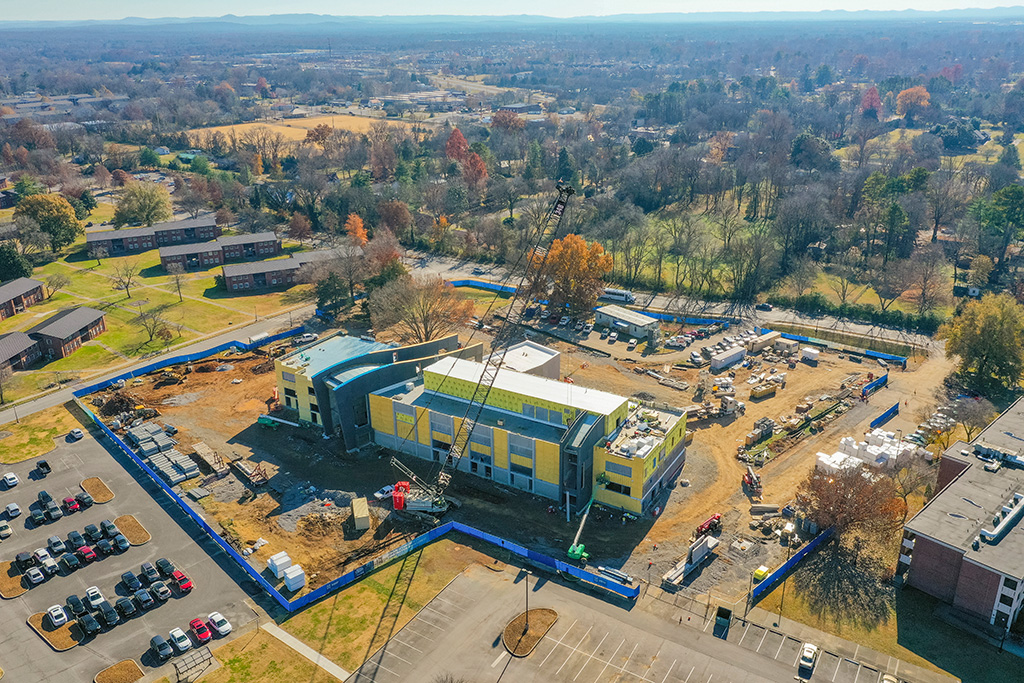
I’ve always thought higher education projects would be the perfect set up for a design build or design assist delivery method. On most projects, the budget target is known up front and it’s up to the design team and contractor to deliver their project within that target. With other market sectors, even if clients have a number in mind, they will most likely wait to see how the bidding process plays out to keep things competitive.
Now, higher education projects have particular hiring processes in place for a reason. Especially public institutions. There are many stakeholders involved, the university’s board, the state board, and a mission to ensure every project is bid publicly and fairly. However, I believe the current volatility in the supply chain and labor market is creating difficulties for these tried-and-true processes, and potentially costing our higher education clients more money, while impacting what can be delivered for that value.
I’d like to make a case for why the higher education hiring processes could benefit from evolving into a more design-build or design-assist pattern, while still keeping the hiring process competitive. You may be thinking I’m just trying to get general contractors (like myself) hired earlier and while I do believe the earlier in a project the contractor is brought on, the better — in this case, I’m really advocating to hire trade partners much earlier in the process.
The Way It’s Done Now
Typically, we’re hired onto higher education projects during the schematic design phase which I believe is the ideal time for us to partner with the design team and help drive the design to budget. An institution issues a Request for Qualifications or a Request for Proposal with their target budget and project scope, and then hires a general contractor based on their qualifications, technical proposal on how they will approach the project, and their contractor fee. The awarded general contractor will then spend the next several months providing cost analysis at different design levels to ensure the overall design stays within the project target budget. That analysis will likely be based on historical unit cost and feedback from the trade market, but no commitments are made to the trades and no materials are secured during this process. Trade bidding will take place once the contractor and designer are confident the final pricing will be within the target budget. This delivery method has proven to be very successful over the years, promoting a collaborative experience for the entire team and delivering a quality project within the target budget.
However, today, construction costs are up. Demand is high. The supply chain is delayed. Labor is hard to find. These factors are creating serious challenges for the traditional higher education delivery method we’ve grown accustomed to. Your general contractor and design team can spend months designing to your budget only to find out that in the six months that’s passed, material costs have soared, and most trade partners are committed to other projects. We’ve written about how right now, key trade partners like steel and concrete are giving prices that are only good for 24 hours. Not to mention, a letter of intent isn’t enough to commit a trade partner to your project or actually secure pricing. They need a contract and certainty before they’re willing to take on that risk. We rely heavily on trade partner pricing feedback during the design process. Numerous rounds of budget pricing can create fatigue for our trade partners, especially knowing the general contractor is not able to make final contract awards.
Some may read this and think I’m suggesting a traditional Design-Bid-Build delivery method would be a more reliable option to combat today’s economic challenges. Not at all. In fact, I believe this method could be a riskier approach. If bid day pricing is not within the bid target, the designer is typically required to modify the design to reduce cost, but without being able to collaborate with the general contractor on cost impacts. This would undoubtedly result in delays in getting the project started and create a tremendous amount of frustration for the entire team.
A New Approach
I’d love to see higher education projects allow the general contractor to hire trade partners like they hire the general contractor and do it much earlier in the design process. I believe we can keep the hiring process open, fair, and competitive if we hire the trade contractors based on qualifications and fees utilizing the RFP/RFQ process. This would promote more accountability and ownership throughout the project team and allow the design and ownership teams to make sound decisions based on accurate feedback. We would have the opportunity to procure select materials earlier to help manage escalation and supply chain issues, which in turn maximizes the value for the owner. This would also help the trade contractors manage manpower needs and maximize efficiency once they are on site.
This different approach to hiring might be uncomfortable for some clients. After all, it means an earlier financial commitment from the client to enable early purchasing and procurement while the design is still underway. But in today’s market, developers can’t afford to wait. The market is so volatile with material costs changing daily and labor becoming harder to find. Meanwhile, the demand isn’t diminishing. I believe it’s time for all market sectors, but especially those that aren’t currently embracing early involvement from key trades, to evolve and ensure their projects aren’t suffering.

